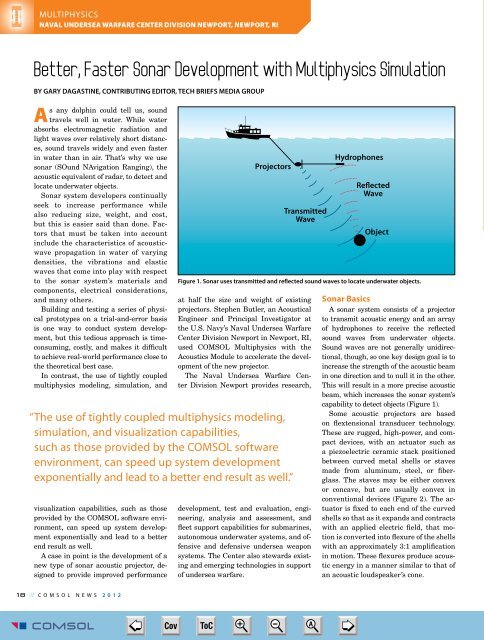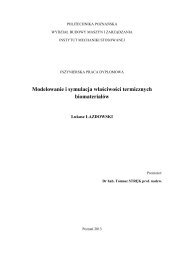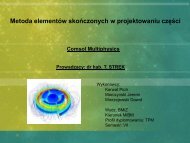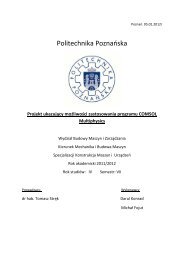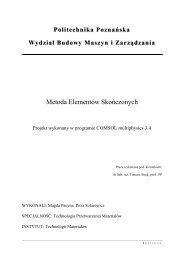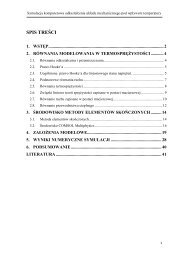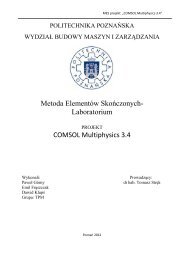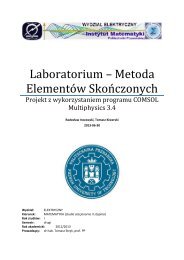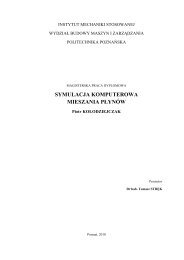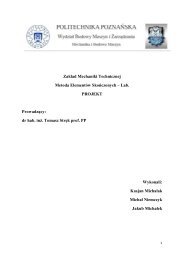COMSOL News
COMSOL News
COMSOL News
You also want an ePaper? Increase the reach of your titles
YUMPU automatically turns print PDFs into web optimized ePapers that Google loves.
MULTIPHYSICS<br />
NAVAL UNDERSEA WARFARE CENTER DIVISION NEWPORT, NEWPORT, RI<br />
Better, Faster Sonar Development with Multiphysics Simulation<br />
BY GARY DAGASTINE, CONTRIBUTING EDITOR, TECH BRIEFS MEDIA GROUP<br />
As any dolphin could tell us, sound<br />
travels well in water. While water<br />
absorbs electromagnetic radiation and<br />
light waves over relatively short distances,<br />
sound travels widely and even faster<br />
in water than in air. That’s why we use<br />
sonar (SOund NAvigation Ranging), the<br />
acoustic equivalent of radar, to detect and<br />
locate underwater objects.<br />
Sonar system developers continually<br />
seek to increase performance while<br />
also reducing size, weight, and cost,<br />
but this is easier said than done. Factors<br />
that must be taken into account<br />
include the characteristics of acousticwave<br />
propagation in water of varying<br />
densities, the vibrations and elastic<br />
waves that come into play with respect<br />
to the sonar system’s materials and<br />
components, electrical considerations,<br />
and many others.<br />
Building and testing a series of physical<br />
prototypes on a trial-and-error basis<br />
is one way to conduct system development,<br />
but this tedious approach is timeconsuming,<br />
costly, and makes it difficult<br />
to achieve real-world performance close to<br />
the theoretical best case.<br />
In contrast, the use of tightly coupled<br />
multiphysics modeling, simulation, and<br />
visualization capabilities, such as those<br />
provided by the <strong>COMSOL</strong> software environment,<br />
can speed up system development<br />
exponentially and lead to a better<br />
end result as well.<br />
A case in point is the development of a<br />
new type of sonar acoustic projector, designed<br />
to provide improved performance<br />
Projectors<br />
at half the size and weight of existing<br />
projectors. Stephen Butler, an Acoustical<br />
Engineer and Principal Investigator at<br />
the U.S. Navy’s Naval Undersea Warfare<br />
Center Division Newport in Newport, RI,<br />
used <strong>COMSOL</strong> Multiphysics with the<br />
Acoustics Module to accelerate the development<br />
of the new projector.<br />
The Naval Undersea Warfare Center<br />
Division Newport provides research,<br />
“ The use of tightly coupled multiphysics modeling,<br />
simulation, and visualization capabilities,<br />
such as those provided by the <strong>COMSOL</strong> software<br />
environment, can speed up system development<br />
exponentially and lead to a better end result as well.”<br />
Transmitted<br />
Wave<br />
Figure 1. Sonar uses transmitted and reflected sound waves to locate underwater objects.<br />
development, test and evaluation, engineering,<br />
analysis and assessment, and<br />
fleet support capabilities for submarines,<br />
autonomous underwater systems, and offensive<br />
and defensive undersea weapon<br />
systems. The Center also stewards existing<br />
and emerging technologies in support<br />
of undersea warfare.<br />
Hydrophones<br />
Reflected<br />
Wave<br />
Object<br />
Sonar Basics<br />
A sonar system consists of a projector<br />
to transmit acoustic energy and an array<br />
of hydrophones to receive the reflected<br />
sound waves from underwater objects.<br />
Sound waves are not generally unidirectional,<br />
though, so one key design goal is to<br />
increase the strength of the acoustic beam<br />
in one direction and to null it in the other.<br />
This will result in a more precise acoustic<br />
beam, which increases the sonar system’s<br />
capability to detect objects (Figure 1).<br />
Some acoustic projectors are based<br />
on flextensional transducer technology.<br />
These are rugged, high-power, and compact<br />
devices, with an actuator such as<br />
a piezoelectric ceramic stack positioned<br />
between curved metal shells or staves<br />
made from aluminum, steel, or fiberglass.<br />
The staves may be either convex<br />
or concave, but are usually convex in<br />
conventional devices (Figure 2). The actuator<br />
is fixed to each end of the curved<br />
shells so that as it expands and contracts<br />
with an applied electric field, that motion<br />
is converted into flexure of the shells<br />
with an approximately 3:1 amplification<br />
in motion. These flexures produce acoustic<br />
energy in a manner similar to that of<br />
an acoustic loudspeaker’s cone.<br />
1 8 // <strong>COMSOL</strong> NEWS 2 0 1 2<br />
<strong>COMSOL</strong> <strong>News</strong> 2012-17.indd 18<br />
➮<br />
Cov ToC + – A<br />
➭<br />
5/15/12 2:59 PM


